An intervening cause refers to an event that occurs after an initial act and contributes to causing harm, potentially affecting legal liability. Understanding the role of intervening causes is crucial in determining whether the original actor remains responsible for the resulting damages. Explore how intervening causes impact legal outcomes and what this means for your claims in the full article.
Table of Comparison
| Aspect | Intervening Cause | Actual Cause |
|---|---|---|
| Definition | An independent event that occurs after the defendant's act, contributing to the harm. | The primary event or act that directly leads to the harm or injury. |
| Role in Causation | Breaks the chain of causation if unforeseeable and independent. | Establishes direct causation between act and injury. |
| Example | A third party's unpredictable action causing additional harm. | Defendant's negligent driving causing a car accident. |
| Legal Impact | May relieve defendant of liability if deemed a superseding cause. | Forms basis for establishing legal responsibility. |
| Foreseeability | Typically unforeseeable and external. | Usually foreseeable and directly linked to act. |
Understanding Causation in Legal Contexts
Intervening cause refers to an unexpected event that breaks the direct link between the defendant's initial act and the ultimate harm, potentially absolving liability by altering the causal chain. Actual cause, or cause-in-fact, establishes that the defendant's conduct was a necessary condition for the harm, typically determined by the "but-for" test. Understanding causation in legal contexts requires differentiating these concepts to assess liability accurately, ensuring that only proximate and foreseeable consequences attribute responsibility.
What is an Actual Cause?
An actual cause, also known as cause-in-fact, refers to the direct action or event that produces a specific outcome or injury in a causal chain. It is established by the "but-for" test, meaning that but for the defendant's conduct, the harm would not have occurred. Identifying the actual cause is essential in tort law to attribute liability before considering any intervening causes that may disrupt the causal link.
Defining Intervening Cause
An intervening cause is an event or act that occurs after the defendant's initial act and contributes to the harm, potentially breaking the chain of causation. It must be unforeseeable and sufficiently independent of the defendant's conduct to relieve liability. The distinction between intervening and actual cause is crucial in determining legal responsibility for resulting damages.
Key Differences Between Actual and Intervening Causes
Actual cause refers to the primary factor that directly leads to an event or harm, often identified through the "but-for" test, determining whether the result would have occurred without that cause. Intervening cause is an independent event that occurs after the actual cause, contributing to the final outcome but potentially breaking the chain of causation if deemed unforeseeable or extraordinary. The key difference lies in the directness and predictability of the cause, where actual cause is the initial necessary condition for harm, while intervening cause may modify or interrupt the causal link depending on its foreseeability and nature.
Legal Significance of Actual Cause
Actual cause establishes the foundational link between a defendant's conduct and the resulting harm, meeting the "but-for" test essential in tort law for liability. Courts prioritize actual cause to determine whether the injury would have occurred absent the defendant's actions, ensuring legal accountability. Intervening causes may affect the scope of liability, but actual cause remains the critical element that triggers legal responsibility in negligence claims.
The Role of Intervening Causes in Liability
Intervening causes act as critical factors that can disrupt the causal link between the defendant's original act and the plaintiff's harm, potentially limiting or negating liability. Courts analyze whether the intervening cause was foreseeable and whether it significantly contributed to the injury, determining if the defendant remains liable. Understanding the role of intervening causes clarifies the boundaries of actual cause and helps allocate responsibility accurately in tort cases.
Examples Illustrating Intervening and Actual Causes
An actual cause directly produces an event without interruption, such as a driver running a red light causing a collision. An intervening cause occurs after the actual cause and modifies the outcome, like a bystander administering incorrect first aid worsening the victim's injuries. Examples clarify that the actual cause sets the event in motion, while the intervening cause influences the final result or extent of harm.
Proximate Cause and Its Relationship to Intervening Cause
Proximate cause defines the primary event legally recognized as producing an injury, while an intervening cause introduces a new, independent factor occurring after the original act. Courts assess whether the intervening cause is foreseeable and sufficiently related to the original act, influencing liability determination. If the intervening cause is deemed foreseeable, the original actor remains liable; if not, the chain of causation may be broken, absolving liability.
Common Legal Defenses Involving Intervening Causes
Intervening causes often serve as critical elements in legal defenses by breaking the causal chain between the defendant's actions and the ultimate harm, thus negating liability. Courts analyze whether the intervening cause was foreseeable or a superseding event to determine if it absolves the defendant from responsibility. Common defenses relying on intervening causes include claims of third-party negligence, natural disasters, or victim's own actions that independently contribute to the injury.
Case Law Highlighting Intervening vs Actual Cause
In tort law, the distinction between actual cause (cause-in-fact) and intervening cause is critical in determining liability. Actual cause refers to the direct, factual cause of harm, established through the "but-for" test as seen in *Palsgraf v. Long Island Railroad Co.* (1928), where foreseeability and direct causation were emphasized. Case law like *Derdiarian v. Felix Contracting Corp.* (1980) highlights intervening cause by showing how unforeseeable, independent acts can break the chain of causation, relieving the original actor of liability.
Intervening Cause Infographic

 libterm.com
libterm.com